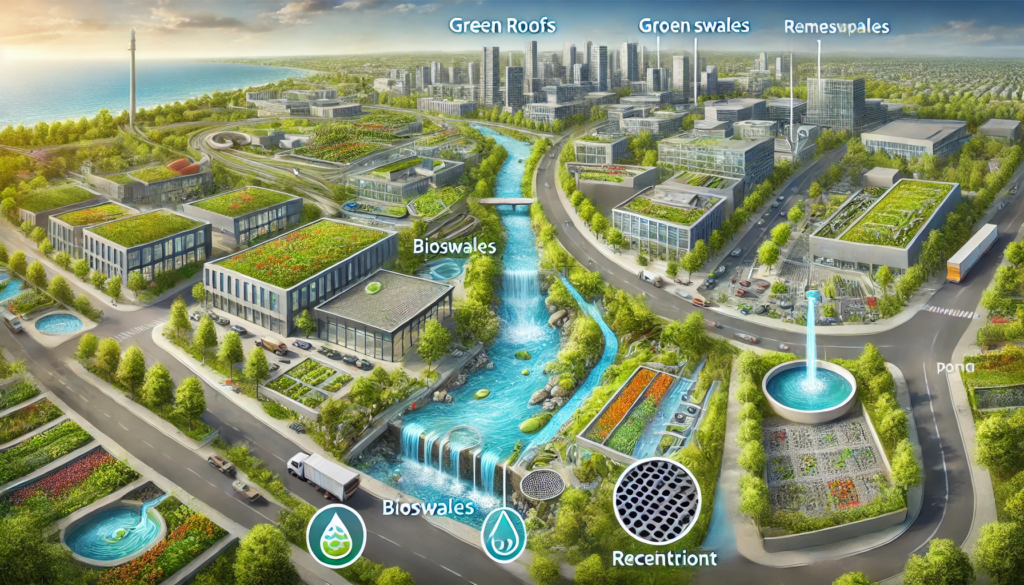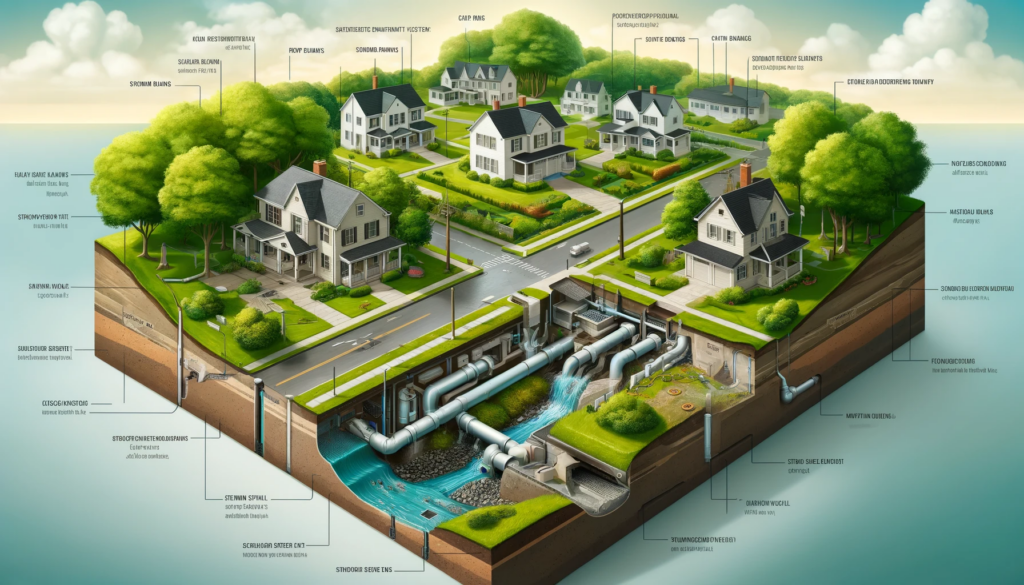Stormwater management is an essential aspect of urban planning and environmental conservation. As Ontario continues to experience rapid urbanization, effective stormwater management has become critical in protecting both natural ecosystems and human settlements. With unpredictable weather patterns, including heavy rainfall and extreme weather events, the need for robust stormwater management Ontario is more urgent than ever. At n Engineering, we specialize in providing comprehensive stormwater management solutions that cater to the unique challenges of Ontario’s diverse geography and urban landscapes.

What Is Stormwater Management?
Stormwater management refers to the control and regulation of runoff generated by rainfall or snowmelt. When rainwater falls on impervious surfaces like roads, parking lots, and roofs, it cannot naturally infiltrate into the ground. Instead, it flows overland, picking up pollutants such as debris, oils, fertilizers, and chemicals along the way. This runoff can overwhelm drainage systems, causing flooding, erosion, and water pollution.
The main goal of stormwater management is to prevent these issues by managing runoff in a way that mimics natural hydrological processes. This involves capturing, storing, and treating stormwater to reduce its negative impact on the environment, infrastructure, and public health.
Why Is Stormwater Management Important in Ontario?
Ontario faces several challenges when it comes to managing stormwater. Some of these challenges are due to the province’s geography, while others arise from rapid urbanization and climate change. Here are some reasons why stormwater management Ontario is so important:
1. Flood Prevention
Flooding is one of the most serious consequences of poor stormwater management. When stormwater runoff is not properly managed, it can overwhelm local drainage systems and flood streets, homes, and businesses. In Ontario, cities like Toronto and Ottawa often experience flooding due to inadequate stormwater infrastructure. Well-designed stormwater management systems help prevent flooding by controlling the flow of water and reducing the amount of runoff that reaches vulnerable areas.
2. Erosion Control
Heavy rainfall and uncontrolled stormwater runoff can erode soil, damage landscapes, and degrade water quality. Erosion is a particular problem in urban areas with paved surfaces and steep slopes. By managing runoff effectively, we can protect soil integrity, prevent sedimentation of rivers and lakes, and preserve the natural beauty of Ontario’s landscapes.
3. Water Quality Protection
Stormwater runoff can carry harmful pollutants into Ontario’s lakes, rivers, and streams. This pollution can harm aquatic ecosystems, reduce biodiversity, and degrade water quality. Effective stormwater management in Ontario ensures that runoff is treated and filtered before it enters water bodies, protecting both the environment and human health.
4. Climate Change Resilience
Ontario is experiencing more frequent and intense storms due to climate change. This increases the volume and speed of stormwater runoff, which, if not properly managed, can lead to more severe flooding and other environmental issues. Implementing effective stormwater management strategies is crucial for building climate resilience in the province.
5. Compliance with Regulations
Ontario’s municipal governments and conservation authorities have established regulations and policies to guide stormwater management practices. These regulations are designed to protect the environment and ensure that development projects are sustainable. Companies like n Engineering play a vital role in helping developers comply with these regulations by designing stormwater management systems that meet local standards.
Stormwater Management Strategies in Ontario
To address the challenges posed by stormwater runoff, several strategies and technologies are being employed across Ontario. Here are some of the most effective stormwater management solutions that are commonly used in the province:
1. Green Infrastructure
Green infrastructure refers to stormwater management techniques that use natural systems and processes to manage runoff. Examples include:
- Rain Gardens: Shallow, vegetated basins that capture and absorb stormwater.
- Green Roofs: Vegetated roofs that absorb rainfall, reducing runoff and improving air quality.
- Permeable Pavement: Paving materials that allow water to seep through and infiltrate into the ground.
Green infrastructure solutions are increasingly popular in Ontario because they provide multiple benefits, such as improving aesthetics, supporting biodiversity, and reducing the urban heat island effect.
2. Retention and Detention Ponds
Retention and detention ponds are designed to capture stormwater runoff and release it slowly over time. Retention ponds store water permanently, while detention ponds temporarily hold water before it is released into the drainage system. These ponds help reduce the risk of flooding, protect water quality, and provide habitat for wildlife.
3. Stormwater Wetlands
Stormwater wetlands are designed to filter stormwater through vegetation and soil before it is released into the environment. These wetlands mimic natural wetlands and are highly effective in removing pollutants, reducing erosion, and promoting biodiversity. They are commonly used in Ontario as part of integrated stormwater management plans.
4. Stormwater Treatment Systems
Stormwater treatment systems are used to remove contaminants from runoff before it is discharged into natural water bodies. These systems include:
- Oil and Grit Separators (OGS): Remove oils, grease, and debris from stormwater.
- Bioretention Cells: Use vegetation and soil to filter out pollutants.
- Constructed Wetlands: Treat runoff by using plant roots and soil to filter out harmful substances.
At n Engineering, we design and implement these systems to ensure compliance with Ontario’s stringent environmental regulations.
5. Infiltration Systems
Infiltration systems, such as soakaways and infiltration trenches, allow stormwater to be absorbed directly into the ground. These systems help replenish groundwater supplies and reduce the volume of runoff entering drainage systems. In Ontario, infiltration is a key strategy in areas with suitable soil conditions.
6. Flow Control Devices
Flow control devices are designed to regulate the speed and volume of stormwater runoff. These devices, including weirs, gates, and valves, help manage the flow of water into drainage systems or treatment facilities. Proper flow control ensures that the stormwater system operates efficiently, reducing the risk of flooding and water pollution.
The Role of n Engineering in Stormwater Management Ontario
As one of Ontario’s leading engineering firms, n Engineering plays a critical role in advancing stormwater management solutions throughout the province. Our team of experienced engineers works with municipalities, developers, and construction firms to design and implement stormwater management system that are sustainable, cost-effective, and compliant with local regulations.
1. Comprehensive Planning
Our team at n Engineering starts by conducting thorough site assessments to understand the unique hydrological conditions of each project. We assess factors such as rainfall patterns, soil types, and the existing stormwater infrastructure. This allows us to develop a comprehensive stormwater management plan tailored to the specific needs of the project and the surrounding environment.
2. Design and Implementation
With a deep understanding of Ontario’s stormwater management regulations, we design customized solutions that reduce runoff, prevent flooding, and improve water quality. Whether it’s the installation of green infrastructure, detention ponds, or stormwater treatment systems, we ensure that our designs are efficient, practical, and meet all environmental standards.
3. Environmental Impact Assessments
Before implementing any stormwater management system, it’s crucial to evaluate its potential impact on the local environment. n Engineering conducts thorough environmental impact assessments to ensure that our designs have minimal adverse effects on local ecosystems. We work closely with regulatory bodies to obtain the necessary permits and approvals before beginning construction.
4. Monitoring and Maintenance
After the installation of stormwater management systems, ongoing monitoring and maintenance are essential to ensure their long-term effectiveness. n Engineering offers maintenance services to keep stormwater systems functioning optimally. We also provide monitoring services to ensure that systems are operating as intended and meeting all regulatory requirements.

Challenges of Stormwater Management Ontario
Despite the progress made in stormwater management, there are still several challenges to overcome in Ontario. These include:
- Aging Infrastructure: Many of Ontario’s stormwater systems are outdated and require significant upgrades to meet modern standards.
- Climate Change: More frequent and intense rainfall events are increasing the strain on stormwater systems, making it necessary to adapt existing infrastructure to cope with changing weather patterns.
- Urbanization: As cities grow, the amount of impervious surfaces increases, leading to more stormwater runoff and greater pressure on existing systems.
- Public Awareness: Educating the public on the importance of stormwater management is crucial for promoting the adoption of green infrastructure solutions.
Conclusion
Effective stormwater management Ontario is vital for protecting the environment, preventing flooding, and ensuring the sustainability of urban development. With the expertise of n Engineering, municipalities and developers can implement innovative, efficient, and sustainable solutions to manage stormwater runoff. By utilizing best practices in stormwater management, Ontario can build resilience against the effects of climate change and continue to grow in a way that is environmentally responsible and sustainable.
n Engineering the best Stormwater Management Consultants remains committed to advancing stormwater management Ontario, providing expert design, planning, and consulting services to ensure a cleaner, safer, and more resilient future.

